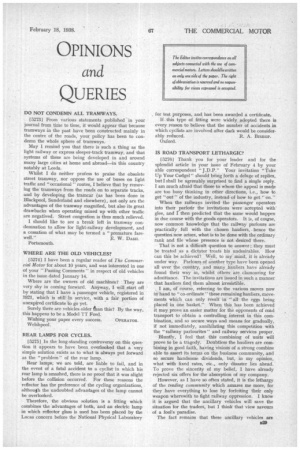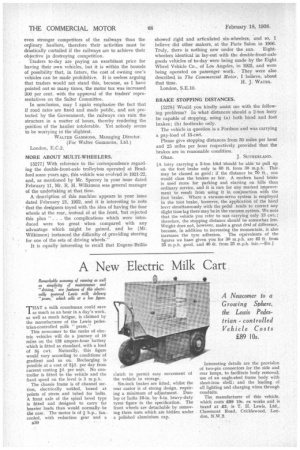OPINIONS
Page 39

Page 40

If you've noticed an error in this article please click here to report it so we can fix it.
and
QUERIES
DO NOT CONDEMN ALL TRAMWAYS.
[5273] From various statements published in your journal from tithe to time, it would appear that because tramways in the past have been constructed mainly in the centre of the roads, your policy has been to condemn the whole sphere of tramways.
May I remind you that there is such a thing as the light railway or express sleeper-track tramway, and that systems of these are being developed in and around many large cities at home and abroad—in this country notably at Leeds.
Whilst I do neither profess to praise the obsolete street tramway, nor oppose the use of buses on light traffic and "occasional" routes, I believe that by removing the tramways from the roads on to separate tracks, and by developing the tramcar (as has been done in Blackpool, Sunderland and elsewhere), not only are the advantages of the tramway magnified, but also its great drawbacks when operating mixed up with other traffic are negatived. Street congestion is thus much relieved.
I should like to see a break left in tramway condemnation to allow for light-railway development, and a cessation of what may be termed a "premature fare
well." i. W. DASH. Portsmouth.
WHERE ARE THE OLD VEHICLES?
[52741 I have been a regular reader of The Commercial Motor for about 10 years, and was interested in one of your "Passing Comments" in respect of old vehicles in the issue dated January 14.
Where are the owners of old machines? They are very shy in coming forward. Anyway, I will start off by stating that I have a passenger vehicle, registered in 1921, which is still in service, with a fair portion of unexpired certificate to go yet. Surely there are vehicles older 13-ian this? By the way, this happens to be a Model TT Ford.
Wishing your paper every success. OPERATOR. Welshpool.
REAR LAMPS FOR CYCLES.
15275]. In the long-standing controversy on this question it appears to have been overlooked that a very simple solution exists as to what is always put forward as the "problem" of the rear lamp.
Rear lamps, we are told, are liable to fail, and in the event of a fatal accident to a cyclist in which his rear lamp is smashed, there is no proof that it was alight before the collision occurred. For these reasons the reflector has the preference of the cycling organizations, although the undoubted advantages of the lamp cannot be overlooked.
Therefore, the obvious solution is a fitting which combines the advantages of both, and an electric lamp in which reflector glass is used has been placed by the Lucas concern before the National Physical Laboratory
. for test purposes, and has been awarded a certificate. If this type of fitting were widely adopted there is every reason to believe that the number of accidents in which cyclists are involved after dark would be consider ably reduced. R. A. BISHOP. Oxford.
IS ROAD TRANSPORT LETHARGIC?
(52781 Thank you for your leader and for the splendid article in your issue of February 4 by your able correspondent " J.D.P." Your invitation Take Up Your Cudgel" should bring forth a deluge of replies, but 'shall be agreeably surprised to find a single reply. I am much afraid that those to whom the appeal is made are too busy thinking in other directions, i.e., how to get "out" of the industry, instead of how to get "on."
When the railways invited the passenger operators
into their parlottr the invitations were accepted with glee, and I then predicted that the same would happen in due course with the goods operators. It is, of cause, now common knowledge that the railway parlours are practically full with the chosen hauliers,. hence the question now arises, what is to be done with the ordinary rank and file whose presence is not desired there.
That is not a difficult question -to answer ; they must
be treated as a dictator treats his undesirables. How can this be achieved? Well, to my mind, it is already under way. Parlours of another type have been opened all over the country, and many hauliers have already found their way in, whilst others are clamouring for admittance. The invitations are issued in such a manner that hauliers find them almost irresistible.
. I am, of course, referring to the various moves now inhand to "co-ordinate " these remaining hauliers, movements which can only result in " all the eggs being placed in one basket." When this has been achieved• it may prove an easier matter for the opponents of road transport to obtain a controlling interest in' this combination, and so secure ways and means for gradually, if not immediately, annihilating this competition with the "railway parlourites" and railway services proper.
Bluntly. I feel that this combining of units will prove to be a tragedy. Doubtless the hauliers are combining in good faith, having visions of a strong combine able to assert its terms on the business community, and so secure handsome dividends, but, in my opinion, what with fixed rates, etc., only disaster lies ahead. To prove the sincerity of my belief, I have already rejected six offers for the absorption of my company.
However, as I have so often stated, it is the lethargy of the trading community which amazes me more, for
they have everything to lose by forfeiting their only weapon wherewith to fight railway oppression. I know it is argued that the ancillary vehicles will save the situation for the traders, but I think that view savours of a fool's paradise.
The fact remains that these ancillary vehicles are
even stronger competitors of the railways than the orilinary hauliers, therefore their activities must be drastically curtailed if the railways are to achieve their objective in destroying competition.
Traders to-day are paying an exorbitant price for having their own vehicles, but it is within the bounds of possibility that, in future, the cost of owning one's vehicles can be made prohibitive. It is useless arguing that traders would not stand this, because, as I have pointed out so many times, the motor tax was increased 300 per cent. with the appoval of the traders' representatives on the Salter Committee.
In conclusion, may I again emphasize the fact that if road rates are fixed and made public, and not protected by the Government, the railways can ruin the structure in a matter of hours, thereby rendering the position of the haulier intolerable. Yet nobody seems to be worrying in the slightest.
WALTER GAMMONS, Managing Director. (For Walter Gammons, Ltd.) London, E .0 .2 .
MORE ABOUT MULTI-WHEELERS.
(5277J With reference to the correspondence regarding the double-front-axle trolley-bits operated at Bradford some years ago, this vehicle was evolved in 1921-22, and, as mentioned by Mr. Sperrey in your issue dated February 11, Mr. R. H. Wilkinson was general manager of the undertaking at that time.
A description of this machine appears in your issue dated February 21, 1922, and it is interesting to note that the designers toyed with the idea of having the four wheels at the rear, instead of at the front, but rejected this plan " . . the complications which were introduced were too great when compared with any advantage which might be gained, and he (Mr. Wilkinson) instanced the difficulty of providing steering for one of the sets of driving wheels."
It is equally interesting to recall that Eugene-Brillie showed rigid and articulated six-wheelers, and so, I believe did other makers, at the Paris Salon in 1906.
Truly, there is nothing new under the sun. Eightwheelers identical in lay-out with the double-front-axle goods vehicles of to-day were being made by the Eight Wheel Vehicle Co., of Los Angeles, in 1923, and were being operated on passenger work. They were also described, in The Commercial Motor, I believe, about
that time. H. J. WATES. London, S.E.10.
BRAKE STOPPING DISTANCES.
[5278] Would you kindly assist me with the following problems? In What distances should a 2-ton lorry be capable of stopping, using (a) both hand and foot brakes ; (b) footbrake only. • The vehicle in question is a Fordson and was carrying a pay-load of 13-cwt.
Please give stopping distances from 30 Miles per hour and 25 miles per hour respectively, provided that the brakes are in reasonable condition.
Oban. 3. SUTHERLAND.
lA lorry carrying a 2-ton keld 'should be able to pull up on the foot brake only in 60 ft. from 30 m.p.h. This may be classed as good; if the distance be 70 ft., One would class the brakes as fair. A modern hand brake is used more for parking and starting on hills than ordinary service, and it is rare for any marked improvement to result from using it in conjunction with the foot brake. Where a vacuum-servo system is employed in the toot brake, however, the application of the hand lever simultaneously with the pedal tends to correct any slight time lag there may be in the vacuum system. We note that the vehicle you refer to was carrying only 13 cwt.: therefore, the stopping distance should be somewhat less. Weight does not, however, make a great deal of difference, because, in addition to increasing the momentum, it also increases the tyre adhesion. The equivalents of the figures we have given you for 30 m.p.h. arc 42 ft. from 25 m.p.h. good, and 46 it. from 25 m.p.h. fair.—En.)




















































































